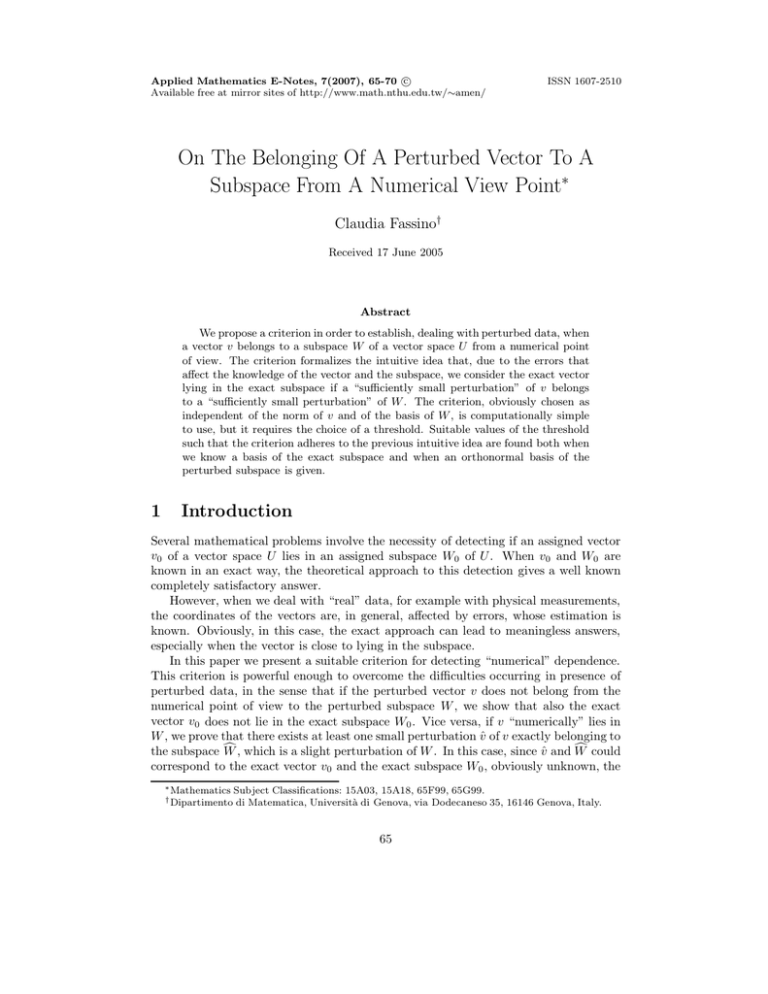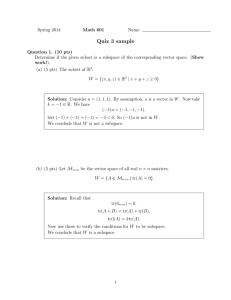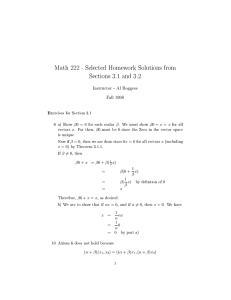Document 10677309
advertisement

c
Applied Mathematics E-Notes, 7(2007), 65-70 Available free at mirror sites of http://www.math.nthu.edu.tw/∼amen/
ISSN 1607-2510
On The Belonging Of A Perturbed Vector To A
Subspace From A Numerical View Point∗
Claudia Fassino†
Received 17 June 2005
Abstract
We propose a criterion in order to establish, dealing with perturbed data, when
a vector v belongs to a subspace W of a vector space U from a numerical point
of view. The criterion formalizes the intuitive idea that, due to the errors that
affect the knowledge of the vector and the subspace, we consider the exact vector
lying in the exact subspace if a “sufficiently small perturbation” of v belongs
to a “sufficiently small perturbation” of W . The criterion, obviously chosen as
independent of the norm of v and of the basis of W , is computationally simple
to use, but it requires the choice of a threshold. Suitable values of the threshold
such that the criterion adheres to the previous intuitive idea are found both when
we know a basis of the exact subspace and when an orthonormal basis of the
perturbed subspace is given.
1
Introduction
Several mathematical problems involve the necessity of detecting if an assigned vector
v0 of a vector space U lies in an assigned subspace W0 of U . When v0 and W0 are
known in an exact way, the theoretical approach to this detection gives a well known
completely satisfactory answer.
However, when we deal with “real” data, for example with physical measurements,
the coordinates of the vectors are, in general, affected by errors, whose estimation is
known. Obviously, in this case, the exact approach can lead to meaningless answers,
especially when the vector is close to lying in the subspace.
In this paper we present a suitable criterion for detecting “numerical” dependence.
This criterion is powerful enough to overcome the difficulties occurring in presence of
perturbed data, in the sense that if the perturbed vector v does not belong from the
numerical point of view to the perturbed subspace W , we show that also the exact
vector v0 does not lie in the exact subspace W0 . Vice versa, if v “numerically” lies in
W , we prove that there exists at least one small perturbation v̂ of v exactly belonging to
c , which is a slight perturbation of W . In this case, since v̂ and W
c could
the subspace W
correspond to the exact vector v0 and the exact subspace W0 , obviously unknown, the
∗ Mathematics
† Dipartimento
Subject Classifications: 15A03, 15A18, 65F99, 65G99.
di Matematica, Università di Genova, via Dodecaneso 35, 16146 Genova, Italy.
65
66
Perturbed Vector in a Subspace
criterion points out the possibility for v0 of belonging exactly to W0 . Therefore the
criterion formalizes the intuitive idea that we consider the exact vector v0 lying in W0
from a numerical point of view if v is “sufficiently near” to W and vice versa.
The criterion, presented in Section 2, has been obviously chosen as independent
of the norm of v and of the basis of the subspace W ; moreover, it is computationally
simple to use. However, the criterion requires the choice of a suitable threshold in order
to adhere to the intuitive idea described above. We also show, in Section 3, how to
choose the threshold both in the simpler case, when a basis of the exact subspace W0
is known and when a set of orthonormal perturbed vectors, which is regarded as the
basis of the perturbed subspace W , is given.
We specify that our interest in this problem arises from the analysis of the BuchbergerMöller algorithm [1] for computing the Gröbner basis of an ideal of polynomials of
Q[x1, . . . , xk], vanishing on a finite set of perturbed points of Qk . At each step, the
numerical version of the Buchberger-Möller algorithm executes a fundamental check
based on the linear dependence of a perturbed vector v on a set of orthonormal perturbed vectors v1 , . . . , vn, and so we need a criterion for the “numerical” belonging of
a vector to a subspace. Then, since this algorithm is implemented using the CoCoA
package [2], which performs all the computations on the rational numbers in exact
arithmetic, we do not deal with roundoff errors and we are only interested in the effects of the errors which perturb the input points. Moreover, for the same reason, the
vectors v1 , . . . , vn, computed from perturbed data, are exactly orthonormal and so we
are interested in the case where an orthonormal basis of the perturbed subspace is
known.
2
On the “Numerical” Dependence
Intuitively, when the exact case is unknown, we suppose the exact vector v0 lying in
the exact subspace W0 if a perturbation v of v0 is “near” to a perturbation W of W0.
We formalize this idea analyzing the ratio kρk/kvk, where ρ is the component of v
orthogonal to W and k · k is the vector 2-norm.
DEFINITION 2.1. Given a subspace W and a threshold S > 0, a vector v “numerically” lies in W if
kρk
≤ S,
(1)
kvk
where ρ is the component of v orthogonal to W . In this case we write v ∈S W .
Condition (1) obviously formalizes the intuitive idea described above in a way dependent only on the subspace W and on the direction of v and then independently
of kvk and of the choice of the basis of W . Therefore, we can suppose kvk = 1 and
W described by an orthonormal basis, if necessary. Moreover, note that, given a basis {v1, . . . , vn} of W , the vector ρ can be obtained computing the residual of a least
squares problem with matrix [v1, . . . , vn] and right-side vector v. However, condition
(1) depends on the choice of the threshold S. Of course, an arbitrary choice of S can
lead to results that do not reflect the intuitive idea. Then it is necessary to analyze
how the threshold can be chosen in relation with the errors on the data. In the next
C. Fassino
67
section, we show how to choose a suitable value of S, in both situations, when we know
the exact subspace W0 and when we know only an approximation of it.
3
The Choice of Suitable Thresholds
We analyze firstly the simpler case when the exact subspace W0 ⊂ U is known. Since
the vector v is perturbed by errors, it can be considered as a representative element of
a set I which contains the unknown exact vector v0 and its “admissible perturbations”.
Given an estimation ε of the relative error which perturbs v componentwise, we denote
by I the set of “admissible perturbations” of v
I = {t ∈ U : kt − vk ≤ εkvk}.
Following the intuitive idea of “numerical” dependence, a suitable threshold S must be
such that if v ∈
/ S W0 then each vector t ∈ I does not lie in W0 , that implies v0 ∈
/ W0.
Vice versa, if v ∈S W0 there exists a vector t̂ of I which belongs to W0 so that it can
happen that v0 lies in W0 .
We want to show that, if W0 is known, the value S = ε is a suitable choice.
(0)
(0)
If {v1 , . . . , vn } is a basis of the exact subspace W0 , then v can be written as
Pn
(0)
v = i=1 αivi + ρ, where ρ ∈ W0⊥ .
Let v ∈
/ ε W0 : then, for condition (1), kρk > εkvk. Since ρ ∈ W0⊥ , for each t ∈ W0,
Pn
(0)
t = i=1 βi vi , we have
kv − tk2 = k
n
X
i=1
(0)
(αi − βi )vi
− ρk2 = k
n
X
(0)
(αi − βi )vi k2 + kρk2.
i=1
We have then kv − tk ≥ kρk > εkvk, and therefore t ∈
/ I.
Vice versa, if v ∈ε W0, that is kρk ≤ εkvk, the vector t̂ = v − ρ, belonging to W0 , is
such that kv − t̂k = kρk ≤ εkvk. It follows that there exists an element of I, the vector
t̂, which also lies in W0.
The more general situation where not only the exact vector v0 , but also the exact
subspace W0 is unknown, requires a different analysis. We suppose to know a set of or(0)
thonormal vectors {v1, . . . , vn}, approximation of the orthonormal basis {v(0) , . . . , vn }
of W0 , and a perturbed vector v, with kvk = 1, approximation of v0. Denoting by W
the subspace spanned by {v1, . . . , vn}, we apply condition (1) for detecting if the perturbed vector v “numerically” belongs to the perturbed subspace W and, as above,
we have to choose a suitable threshold S. With respect to the previous case, there is
a conceptual difference because in this situation we have to analyze also the effects of
small perturbations of the basis of W . For this reason, a suitable threshold is such
that if v ∈
/ S W , the vectors {v1 , . . . , vn, v} are linearly independent even if all of them
are slightly perturbed. Vice versa, if v ∈S W , we require that there exists a small
perturbation of {v1, . . . , vn, v} which is a set of linear dependent vectors.
We suppose that ε is an estimation of the componentwise relative errors such that
(0)
(0)
kV −V0 k ≤ εkV k, where V0 = [v1 , . . . , vn , v0 ] and V = [v1, . . . , vn, v] are, respectively,
68
Perturbed Vector in a Subspace
the matrices formed by the exact and the perturbed vectors, and k k is the 2-norm of
a matrix. We define the set of the “admissible perturbations” as:
I = {B | kV − Bk ≤ εkV k}.
A suitable threshold must be such that, if v ∈
/ S W , all the elements of I are full
(0)
(0)
rank matrices, and so, since V0 ∈ I, the exact vectors v1 , . . . , vn , v0 are linearly
independent. Vice versa, if v ∈S W , the value of S must be such that a deficient rank
(0)
(0)
matrix B̂ ∈ I exists. Since B̂ can correspond to V0 , the exact vectors v1 . . . vn and v0
could be linearly dependent.
It is well known [3] that, if σn+1 is the least singular value of V , then
σn+1 =
min
kB − V k.
rank(B)=n
Therefore a suitable threshold must be such that the condition v ∈
/ S W implies
εkV k < σn+1,
(2)
ensuring that all the elements of I are full rank matrices. Vice versa, the condition
v ∈S W must imply εkV k ≥ σn+1. Since the largest singular value σ1 of V is σ1 = kV k,
the inequality (2) can be rewritten as εσ1 < σn+1. Condition (2) points out that, when
the relative error ε is greater than 1, the problem of belonging of v to W is intrinsically
ill posed. In fact in this case εkV k = εσ1 ≥ σn+1 and then, independently of the choice
b ∈ I. Therefore later on we suppose
of S, always there exists a rank deficient matrix B
ε < 1.
The following theorem gives the singular values of the matrix V .
THEOREM 3.1. Let {v1, . . . , vn} be a set of orthonormal vectors in Rm , m > n,
and let v ∈ Rm be a vector such that
v=
n
X
αivi + ρ with ρ ∈ Span{v1 , . . ., vn }⊥.
i=1
Then the singular values of the matrix V = [v1 , . . ., vn, v] are
q
p
1
σ1 = √
1 + kvk2 + (1 + kvk2)2 − 4kρk2 ≥ 1,
2
σ2 = · · · = σn = 1,
q
p
1
σn+1 = √
1 + kvk2 − (1 + kvk2)2 − 4kρk2 ≤ 1.
2
2
PROOF. It is well known [4] that the values σ12 , . . ., σn+1
are the eigenvalues of the
matrix M = V tV ,
In
α
M=
,
αt kvk2
where αt = (α1 . . . αn) and In is the n × n identity matrix.
C. Fassino
69
Let Mj be the principal submatrix of M formed by selecting the last j rows and
the last j columns, and let dj be the determinant of (Mj − λIj ). If we compute dn+1
with respect to the first row, we have
dn+1 = (1 − λ)dn − α21(1 − λ)n−1
and, in an analogous way,
dj+1 = (1 − λ)dj − α2n−j+1(1 − λ)j−1 ,
so that
dn+1 = (1 − λ)n d1 − kαk2(1 − λ)n−1 .
Since d1 = kvk2 − λ and kvk2 = kρk2 + kαk2, we obtain
dn+1 = (1 − λ)n−1 λ2 − (1 + kvk2 )λ + kρk2 ,
so that the eigenvalues of V tV are 1, with algebraic multiplicity n − 1, and
i
p
1h
λ+ =
1 + kvk2 + (1 + kvk2)2 − 4kρk2 ,
2
i
p
1h
λ− =
1 + kvk2 − (1 + kvk2)2 − 4kρk2 .
2
Since kρk2 ≤ kvk2, it is easy to verify that λ+ ≥ 1 and λ− ≤ 1, from which the theorem
follows.
As consequence of Theorem 3.1, since kvk = 1, the inequality (2) can be rewritten
as
q
q
p
p
ε 1 + 1 − kρk2 < 1 − 1 − kρk2,
and therefore, when ε < 1, it is equivalent to
kρk >
2ε
.
1 + ε2
The previous analysis indicates that the value S = 2ε/(1 + ε2 ) is a suitable choice for
the threshold in this more general case.
4
Conclusions
We have proposed a threshold dependent criterion for establishing when a vector v
belongs to a subspace W from a numerical point of view if v and, in a more general
case, W are perturbed by errors. When an estimation ε of the relative error on the
data is known, we show that the following values of S are suitable threshold:
i) S = ε if a basis of the exact subspace is known,
ii) S = 2ε/(1 + ε2 ) if an orthonormal basis of the perturbed subspace is given and
kvk = 1.
Several numerical tests straightforwardly confirm, from the computationally point
of view, the theoretical evaluations (i) and (ii) of the threshold S.
70
Perturbed Vector in a Subspace
References
[1] B. Buchberger and H. Möller, The construction of multivariate polynomials with
preassigned zeros, in: Proceedings of the European Computer Algebra Conference
(EUROCAM 82), Vol. 144 of Lectures Notes In Comp. Sci., Springer, Marseille France, 1982, pp. 24–31.
[2] J. Abbott, A. Bigatti, M. Kreuzer and L. Robbiano, Computing ideals of points,
JSYMC 30(4)(2000) 341–356.
[3] Å. Björck, Numerical Methods for Least Squares Problems, SIAM, Philadelphia,
1996.
[4] G. H. Golub and C. V. Loan, Matrix Computations. Second Edition, The Johns
Hopkins University Press, Baltimore, Maryland, 1991.






